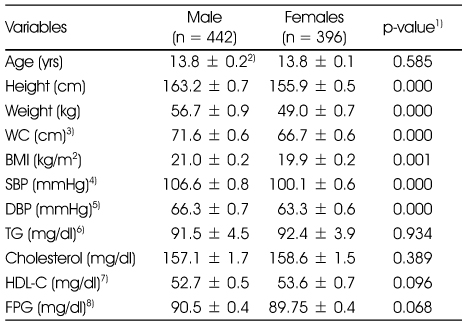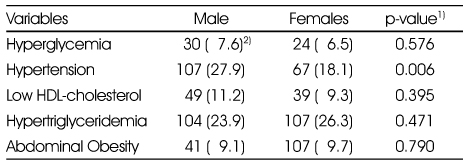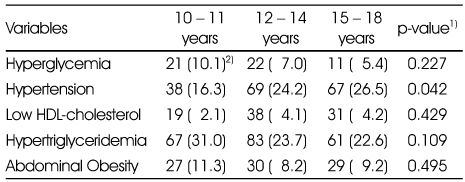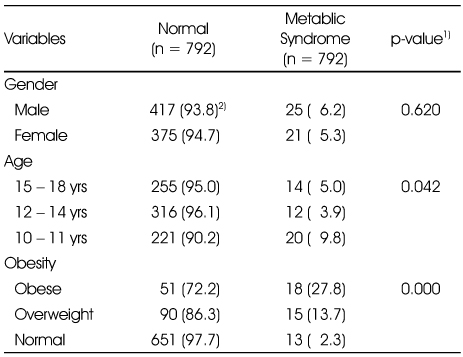References
1. Ambrosini GL, Huang RC, Mori TA, Hands BP, O'Sullivan TA, Klerk NH, Beilin LJ, Oddy WH. Dietary patterns and markers for the metabolic syndrome in Australian adolescents. Nutr Metab Cardiovasc Dis 2010;20(4):274–283.
2. Casazza K, Dulin-Keita A, Gower BA, Fernandez JR. Differential influence of diet and physical activity on components of metabolic syndrome in a multiethnic sample of children. J Am Diet Assoc 2009;109(2):236–244.
3. Chang JH, Kim DH, Kim HS, Choi IK, Cheong MY, Kin DK. Prevalence of metabolic syndrome in obese children. Korean J Pediatr 2004;47(11):1149–1156.
4. Chen W, Xu J, Srinivasan SR, Berenson GS, Li S. Metabolic syndrome variables at low levels in childhood are beneficially associated with adulthood cardiovascular risk. Diabetes Care 2005;28(1):126–131.
5. Cho YG, Song HG, Kang JH. Prevalence of the metabolic syndrome in Korean children and adolescents according to the international diabetes federation definition in children and adolescents. Korean J Fam Med 2009;30(4):261–268.
6. Choi MK, Jun YS, Bae YJ, Sung CJ. A study on nutrient intakes and blood parameters of adult men and women with metabolic syndrome. J Korean Soc Food Sci Nutr 2007;36(3):311–317.
7. Cook S, Weitzman M, Auinger P, Nguyen M, Dietsz WH. Prevalence of a metabolic syndrome phenotype in adolescents findings from the third national health and nutrition examination survey, 1988-1994. Arch Pediatr Adolesc Med 2003;157(8):821–827.
8. de Ferranti SD, Gauvreau K, Ludwig DS, Niufeld EJ, Jane W. Prevalence of the metabolic syndrome in American adolescents: findings from the third national health and nutrition examination survey. Circulation 2004;110(16):2494–2497.
9. Ford ES, Ajani UA, Mokdad AH. The metabolic syndrome and concentrations of C-reactive protein among U.S. youth. Diabetes Care 2005;28(4):878–881.
10. Ford ES, Giles WH, Mokdad AH. Increasing prevalence of the metabolic syndrome among U.S. adults. Diabetes Care 2004;27(10):2444–2449.
11. Grundy SM, Brewer HB Jr, Cleeman JI, Smith SC Jr, Lenfant C. Definition of metabolic syndrome: report of the National Heart, Lung, and Blood institute/American Heart Association conference on scientific issues related to definition. Circulation 2004;109:433–438.
12. Huh K. Metabolic syndrome in Korean children and adolescents; from the Korean NHANES 1998~2007 data analysis Inje University; 2009. MS thesis.
13. Isomaa B, Almgren P, Tuomi T, Forwen B, Lahti K, Nissen M, Taskinen MR, Groop L. Cardiovascular morbidity and mortality associated with the Metabolic syndrome. Diabetes Care 2001;24(4):683–689.
14. Dallongeville J, Jean BR, Dominique C, Bernadette H, Jean F, Pierre D, Dominique A, Philippe A, Annie B. Household income is associated with the risk of metabolic syndrome on a sex-specific manner. Diabetes Care 2005;28(2):409–415.
15. Jung JH. Associations between metabolic syndrome and nutrient intake and health-related risk factors Sungshin Women's University; 2009. MS thesis.
16. Kim DI, Kim JY, Lee MK, Lee HD, Lee JW, Jeon JY. The relationship between fitness, BMI and risk factors of metabolic syndrome among university students in Korea. Korean J Obes 2012;21(2):99–107.
17. Kong KA. Prevalence and risk factors of metabolic syndrome in young schoolchildren Seoul: Ewha Womans University; 2008. Dissertation.
18. Korea Centers for Desease Control and Prevention. Report on 2008 national health and nutrition survey 2009.
19. Kwon HS, Park YM, Lee HJ, See JH, Choi YH, Ko SH, Lee JM, Kim SR, Kang SY, Lee WC, Ahn MS, Noh JH, Kang JM, Kim DS, Yoon KH, Chal BY, Lee DW, Kang SK, Son HY. The prevalence and clinical characteristics of the metabolic syndrome in middle-aged Korean adult. Korean J Med 2005;68(4):359–368.
20. Kwon SY. The study of association between metabolic syndrome and dietary factors among mothers and their children based on the data from 2007-2010 KNHANES Catholic University; 2014. MS thesis.
21. Lee CG, Moon JS, Choi JM, Nam CM, Lee SY, Oh KW, Kim YT. Normative blood pressure references for Korean children and adolescents. Korean J Pediatr 2008;51(1):33–41.
22. Lee MS, Sung CJ, Sung MK, Choi MK, Lee YS, Cho KO. A comparative study on food habits and nutrient intakes among high school students with different obesity indexes residing in seoul and Kyunggi-do. Korean J Community Nutr 2000;5(2):141–151.
23. Lim HS, Kim SK. Comparative of the nutritional status and correlation of cardiovascular disease in type II diabetes mellitus patients with metabolic syndromes. Korean J Nutr 2008;41(4):327–340.
24. Lim S, Jang HC, Park KS, Lee HK, Chung HR, Joung HJ, Cho SI. Changes in metabolic syndrome of Korean children and adolescents in the period 1998 to 2001. J Endocrinol Invest 2008;31(4):327–333.
25. Lim S, Lee HK, Park KS, Cho SI. Changes in the characteristics of metabolic syndrome in Korea over the period 1998-2001 as determined the Korean national health and nutrition examination surveys. Diabetes Care 2005;28(7):1810–1812.
26. Moon JS, Lee SY, Nam CM, Choi JM, Choi BK, Seo JW, Oh KW. 2007 Korean National Growth Charts : Review of developmental process and outlook. Korean J Pediatr 2008;51(1):1–25.
27. Morrison JA, Friedaman SA, Wang P, Glueck CJ. Metabolic syndrome in childhood predicts adult metabolic syndrome and type 2 diabetes mellitus 25 to 30 years later. J Pediatr 2008;152(2):201–206.
28. Park JS, Park ES. Prevalence of metabolic syndrome and nutrient intakes of obese middle school students in Korea - Focused on Namwon city, Jeonbuk. J Korean Living Sci Assoc 2008;17(1):159–170.
29. Park MJ, Yun KE, Lee GE, Cho HJ, Park HS. The relationship between socioeconomic status and metabolic syndrome among Korean adults. Korean J Obes 2006;15(1):10–17.
30. Reaven GM. Role of insulin resestance in human disease. Diabetes 1988;37:1595–1607.
31. Roh DJ. Prevalence of insulin resistance and metabolic syndrome and effects of health promotion program among obese children in Jeju Jeju National University; 2012. Dissertation.
32. Wamala SP, Murray AM, John L, Karin SG, Myriam H, Kristina OG. Education and the metabolic syndrome in women. Diabetes Care 1999;22(12):1999–2003.
33. Seo MJ, Seong JW, Sohn KJ, Ko BJ, Han JH, Kim SM. Prevalence of the metabolic syndrome in Korean children and adolescents. J Korean Acad Fam Med 2006;27(10):798–806.
34. Seo SJ. A study on the prevalence and the risk factors of metabolic syndrome in Korean children and adolescents Seoul National University; 2006. MS thesis.
35. The Korean Nutrition Society. Dietary Reference Intakes for Korean, Seoul 2005.
36. Weinberger MH, Finegerg NS. Sodium and volume sensitivity of blood pressure: age and pressure change over time. Hypertension 1991;18:67–71.
37. Yoo HJ, Kim YH. A study on the characteristics of nutrient intake in metabolic syndrome subjects. Korean J Nutr 2008;41(6):510–517.
38. Yoon YS. Trends of prevalence and associated factors of metabolic syndrome in Korean children and adolescents -Using the Korea national health and nutrition examination survey Ulsan University; 2008. Dissertation.






